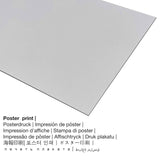Winslow Homer, 1895 - Cannon Rock - fine art print
Tax included. Shipping calculated at checkout.
Specification of the product
Cannon Rock was by the male painter Winslow Homer in 1895. The work of art had the following size: 40 x 40 in (101,6 x 101,6 cm) and was made with the technique oil on canvas. Furthermore, this piece of art can be viewed in in the digital collection of The Metropolitan Museum of Art located in New York City, New York, United States of America. With courtesy of: The Metropolitan Museum of Art, New York, Gift of George A. Hearn, 1906 (license: public domain). Creditline of the artwork: Gift of George A. Hearn, 1906. Moreover, alignment of the digital reproduction is in square format and has a side ratio of 1 : 1, meaning that the length is equal to the width. Winslow Homer was a male painter from United States, whose art style can be classified as Realism. The Realist painter lived for 74 years and was born in 1836 in Boston, Suffolk county, Massachusetts, United States and deceased in the year 1910.
Select your item material option
For every fine art print we offer a range of different sizes & materials. Choose among the following product options now to match your preferences in size and material:
- Aluminium dibond print: These are metal prints on aluminium dibond with an outstanding depth, which makes a contemporary impression with a surface , which is not reflective. For your Aluminium Dibond option, we print your selected artpiece right onto the surface of the aluminum. The bright and white sections of the original work of art shine with a silk gloss but without any glow. The colors are vivid and luminous, the fine details of the print appear clear and crisp. The direct print on aluminium is one of the most popular entry-level products and is a truly stylish way to showcase fine art prints, because it draws focus on the whole artwork.
- Printed poster (canvas material): The poster print is a printed sheet of canvas with a nice surface texture. Please note, that depending on the size of the poster we add a white margin between 2 - 6cm round about the painting to facilitate the framing.
- The canvas print: The UV printed canvas mounted on a wooden stretcher frame. The great advantage of canvas prints is that they are relatively low in weight. This means, it is easy to hang up the Canvas print without the support of additional wall-mounts. Canvas prints are suited for all types of walls.
- Acrylic glass print (with real glass coating on top): An acrylic glass print, often described as a plexiglass print, will turn your chosen artwork into beautiful décor. The artwork is printed with modern UV print technology. The result of this are impressive and vivid colors. With an acrylic glass fine art print contrasts as well as smaller painting details will be more identifiable due to the subtle gradation.
Legal disclaimer: We try in order to describe the products as accurate as possible and to showcase them visually in our shop. Although, the tone of the printing material and the print result may differ somehwat from the representation on the device's monitor. Depending on the screen settings and the quality of the surface, not all colors are printed as realisitcally as the digital version shown here. Because all the fine art prints are processed and printed manually, there might also be slight discrepancies in the motif's size and exact position.
The product specifications
| Article classification: | fine art reproduction |
| Reproduction method: | digital reproduction |
| Manufacturing method: | digital printing |
| Production: | German-made |
| Stock type: | on demand |
| Intended product use: | home design, home décor |
| Image orientation: | square alignment |
| Image aspect ratio: | 1 : 1 length to width |
| Image aspect ratio meaning: | the length is equal to the width |
| Product material variants: | acrylic glass print (with real glass coating), poster print (canvas paper), metal print (aluminium dibond), canvas print |
| Canvas print (canvas on stretcher frame) options: | 20x20cm - 8x8", 30x30cm - 12x12", 50x50cm - 20x20", 70x70cm - 28x28", 100x100cm - 39x39" |
| Acrylic glass print (with real glass coating) sizes: | 20x20cm - 8x8", 30x30cm - 12x12", 50x50cm - 20x20", 70x70cm - 28x28", 100x100cm - 39x39" |
| Poster print (canvas paper) variants: | 30x30cm - 12x12", 50x50cm - 20x20", 70x70cm - 28x28", 100x100cm - 39x39" |
| Aluminium print (aluminium dibond material) size variants: | 20x20cm - 8x8", 30x30cm - 12x12", 50x50cm - 20x20", 70x70cm - 28x28", 100x100cm - 39x39" |
| Framing of the art copy: | not included |
Structured table of the piece of art
| Name of the work of art: | "Cannon Rock" |
| Classification of the artpiece: | painting |
| Generic term: | modern art |
| Temporal classification: | 19th century |
| Created in the year: | 1895 |
| Age of artwork: | around 120 years old |
| Original medium of artwork: | oil on canvas |
| Size of the original artpiece: | 40 x 40 in (101,6 x 101,6 cm) |
| Museum / collection: | The Metropolitan Museum of Art |
| Location of museum: | New York City, New York, United States of America |
| Website: | www.metmuseum.org |
| Artwork license: | public domain |
| Courtesy of: | The Metropolitan Museum of Art, New York, Gift of George A. Hearn, 1906 |
| Creditline: | Gift of George A. Hearn, 1906 |
Contextual artist information
| Name: | Winslow Homer |
| Aliases: | w. homer, הומר וינסלאו, homer w., Winslow Homer, Homer, Homer Winslow |
| Gender of the artist: | male |
| Artist nationality: | American |
| Professions: | painter |
| Country of origin: | United States |
| Artist classification: | modern artist |
| Art styles: | Realism |
| Age at death: | 74 years |
| Birth year: | 1836 |
| Birthplace: | Boston, Suffolk county, Massachusetts, United States |
| Died: | 1910 |
| City of death: | Prouts Neck, Cumberland county, Maine, United States |
Copyright ©, Artprinta (www.artprinta.com)
Supplemental information from the museum (© - by The Metropolitan Museum of Art - www.metmuseum.org)
Homer spent most of the last twenty-five years of his life at Prouts Neck, Maine, which lies on a rugged stretch of the Atlantic coast about twenty miles south of Portland. There, he painted several of his most powerful seascapes—scenes that express his appreciation of nature’s power. Cannon Rock took its name from its resemblance to a cannon seen from behind and from the booming sound of the surf breaking at its base. For this painting, Homer seems to have distilled from nature its elemental components—rocky shore, pounding sea, and leaden sky—and arranged them on the square canvas with impressive graphic skill.














